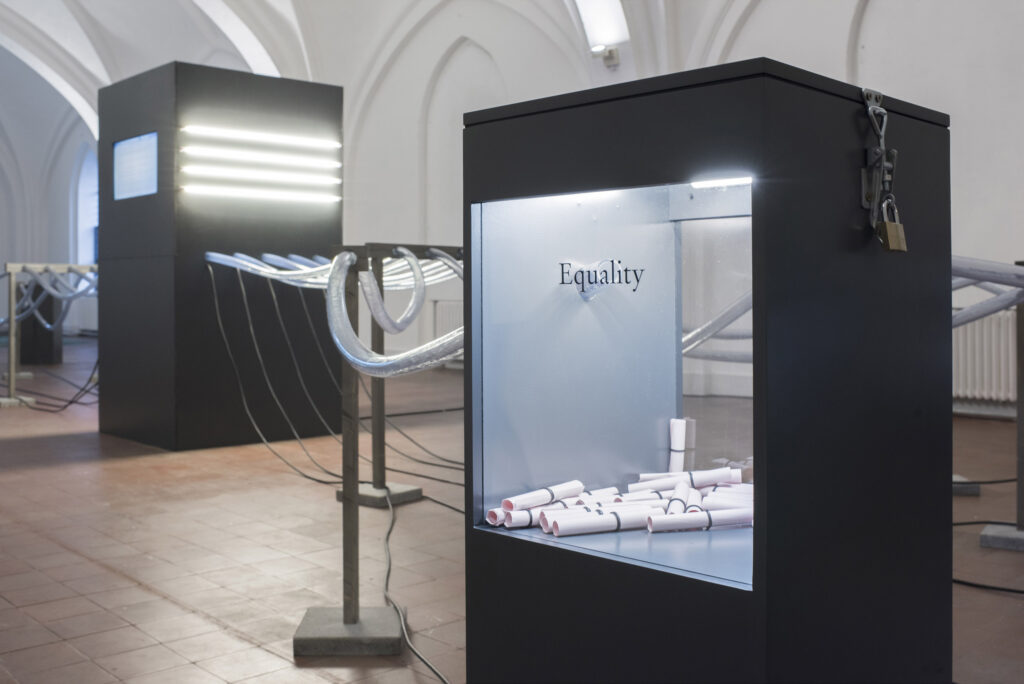The arts as a forum – on the role of arts in a democratic society
Frederik Tygstrup (1959) has written numerous works on the history of literature, specialising on the European novel, literary theory and modern history of the arts. In recent years, he has explored the boundaries between the arts and culture and broader societal issues, including literature and medicine,
literature and geography, and literature and politics. He is currently heading the research projects “Finance Fiction” (Danmarks Frie Forskningsfond 2018-2022) and “Art as Forum” (Ny Carlsbergfondet 2020-2024), an interdisciplinary and internationally oriented research center that produces and disseminates new knowledge about the value of art in society.
Photo: Frida Gregersen

In spring 2018, the Danish artist Stine Marie Jacobsen exhibited her work “Law Shifters” in Nikolaj Kunsthal in Copenhagen. This is a large installation, with a three-metre tall box fitted with lights and computer screens that are connected by pneumatic tubes to a number of writing pulpits on one side, and a number of storage cabinets on the other. Visitors to the exhibition could stand at pulpits and write suggestions for new Danish or European legislation. These were sent as capsules in the pneumatic tubes to the big law machine. In the central machine, the suggestions were forwarded to writers and lawyers, who processed them into final legal proposals that were published simultaneously in an installation in Maastricht.

This work of art has an obvious political content, since it questions what is right and what is legal. But it also – and perhaps even more importantly – has a political form. The work addresses a question to the audience. A myriad of impressions with various references to notions of law and justice are followed by an invitation to formulate oneself under the influence of the work. Stine Marie Jacobsen’s piece is a perfect example of contemporary installation art that engages the viewer and integrates social relations in its form and style: law as social relations is present in the social relationship surrounding the work. Works such as this, however, also alert us to two more fundamental qualities of art.
Firstly, that works of art always have the nature of an inquiry. In Jacobsen, this is clearly manifested. But even when the inquiry is not the theme itself, a basic feature of art and our notion of art is that it addresses an audience. Works of art are objects or happenings – regardless of whether they consist of words, images, plastic shapes, notes or movement – that are displayed, published or performed and thereby presented to a public.
And secondly, the inquiry of art does not primarily convey a message or communicate an idea, but asks the audience a
question. The work of art presents a form, an image, and asks the audience how they react to it. Art does not supply an answer but asks for a reaction: the viewer’s feelings, experience, insights.
A work of art always entails an encounter – an encounter between me, the individual audience member, and the work. But it is also an encounter between all of us who enter into this situation together. As a viewer of a work of art – in the broadest sense, regardless of whether I read a book at home in my sofa or sit in a theatre – I am part of a community consisting of the many (or few) who have chosen to receive this inquiry. Around the work of art, a forum, a meeting place, arises where we are brough together because we are all listening to the question the art is asking us.
The value of art has been described in many different ways. Art has a value in that it offers particular experiences, sensual and mental pleasure, through beautiful shapes and moving stories. And art has a value in that it offers an insight into the world, into how others think and feel. And lastly, art is valuable because it challenges its audience by describing the world in new and different ways. If we regard art as a forum, we discover another aspect of the value of art: namely that the experiences, insights and challenges that art offers are something that brings people together. A work of art gives not just an individual experience, but an experience we share with others – across time and space. It is the experience of uniting around questions, around problems, rather than around answers. Therefore, art is a crucial part of the infrastructure of a democratic society, with citizens who can reflect together on their experiences, thoughts and feelings, and ultimately on the premises for community.